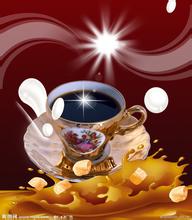Introduction of varieties of grinding scale for distinguishing flavor description between sun-cured and washed coffee beans
Introduction of varieties of grinding scale for distinguishing flavor description between sun-cured and washed coffee beans
Sun Yega Chuefei: the sun is a little complex, light fermented wine, bitter taste will be more intense, taste will be much more rich, honey sweet, cocoa with a hint of spice, body thick and long-lasting.
Water washing Yega Xuefei: the acidity of the water washing treatment will be brighter, like citric acid, the taste is more fragrant, citrus is more obvious, and there is some black tea in the latter part. The peel, pulp and mucous membrane are removed by washing and fermentation. farms that use the washing method must build washing ponds and be able to introduce an endless supply of live water. During the treatment, the finished beans are put into the pool and passed back and forth, using the friction of beans and the power of running water to wash the coffee beans until smooth and clean. After washing, at this time, the coffee beans are still wrapped in the pericarp with a moisture content of 50%. They must be dried to reduce the moisture content to 12%, otherwise they will continue to be mellow, moldy and rotten. The better treatment is to use sunlight to dry, although it takes 1 ~ 3 weeks, but it has a very good flavor and is very popular.
Sun-cured coffee accounts for 65% of exports. Mainly picked by families, red coffee beans are placed on cement floors or on high tables to dry to about 11.5% humidity, then peeled and cleaned. Sun-dried beans have a complete natural mellow flavor, gentle aroma and more gelatinous so-called honey treatment (Miel Process in Spanish), which is said to mean the process of making raw beans with a mucous membrane for sun-drying. After the outer pulp of the coffee bean is removed, there will be a layer of sticky jelly. The traditional washing method is to wash it off with clean water, but because of the limitation of water resources in some high-altitude areas, this direct drying method is to spread coffee cherries widely on the exposure field for two weeks and sweep them with rakes several times a day, so that coffee beans can be dried more evenly. When dried, the coffee beans are separated from the skin, and the dried pulp and peel are removed by a sheller, then screened and divided into different grades. However, because the drying method requires good weather and venues, there are some limitations, so it is rarely used completely. In many places, a combination of drying and washing is used. Semi-washed coffee accounts for 35% of the export. Good quality washed coffee is processed with freshly picked fully ripe fruit, picked carefully and closely monitored by professionals. The picked clean coffee beans are pulped on the day of picking, then fermented, washed, dried and peeled. The humidity of processed coffee beans is kept at about 12%. The washing rule has a good mellow taste, a high aroma and a lively sour taste.

Important Notice :
前街咖啡 FrontStreet Coffee has moved to new addredd:
FrontStreet Coffee Address: 315,Donghua East Road,GuangZhou
Tel:020 38364473
- Prev

Introduction to the Grinding scale of Coffee Bean varieties produced in Manor by Sun washing and Taste treatment
Introduction to the grinding scale of coffee bean varieties treated by sun washing taste in the manor area [Solar Yega Snow]: it is recommended to use 15g powder at 89 degrees water temperature, small Fuji grinding degree 4min V60 filter cup, water powder ratio at 1:15, the first water injection 30g, steaming 25s, the second water injection 104g water cut off, the second water injection to 230g water, not the water at the end, the extraction time is about 2range 12s;
- Next

The difference between coffee washing, honey treatment and sun exposure jies
Introduction to the difference between coffee washing, honey treatment and sun exposure. The process of natural solarization (Natural/Dried-in-the-Fruit) is the simplest. The fruit begins the process of sun drying without treatment after picking. This is the oldest method of treatment in existence. This method is still used in places such as Ethiopia and Brazil. Natural solarization in the absence of water resources
Related
- What is the meaning of lactic acid fermentation with coffee bean treatment?
- How to judge the state of foam by sound?
- How does the latte pull out the unicorn pattern? Come to get for a little trick to improve the flower pull!
- Will flower pulling affect the taste of the latte?
- Do you know the history of coffee?
- The difference between honey treatment and sun washing what is raisin honey treatment?
- What kind of milk can a novice use to make coffee foam to keep the foam longer? The correct method and skills of milking tutorial sharing
- Why do washed coffee beans taste sour? Flavor characteristics of washed Coffee
- Introduction to the skill of how to practice the size and height of water injection around the circle of hand-brewed coffee
- How do beginners practice coffee flower drawing from scratch?

